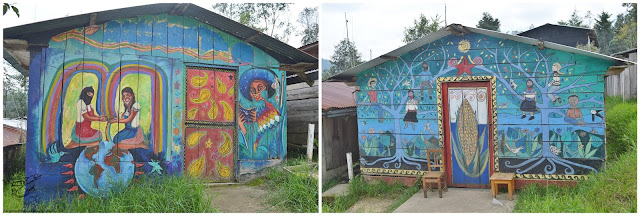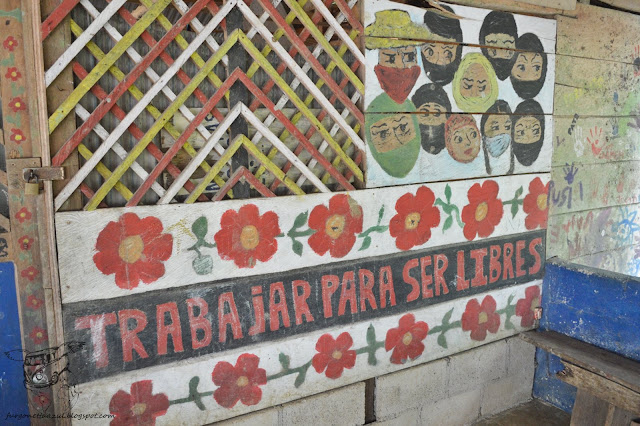Aún recuerdo cuando llegó a mis manos las primeras informaciones de los zapatistas y el Subcomandante Marcos, allá en los 90. Imagine en mi cabeza la selva Lacandona y los lugares que leía en los libros, los aguascalientes de aquella época y sentía mucha empatía por aquellos que se sublevaron en forma de guerrilla.
Pues bien 22 años de aquel histórico 1 de enero de 1994, día en que el E.Z.L.N, se alzo en armas y tomo varias cabeceras del estado de Chiapas, nosotros pudimos adentrarnos dentro de esos territorios.
El E.Z.L.N, a día de hoy sigue siendo un referente mundial de la lucha, cuyo objetivo sigue siendo el mismo que antes , y no es otro que el que comunico el subcomandante Marcos: "¿tomar el poder?No ,apenas algo mas difícil, un Mundo Nuevo".
Sus exigencias básicas son claras y son la lucha por el trabajo, la tierra, el techo, la alimentación, la educación ,la independencia, la salud y como no, libertad, justicia, democracia y paz.
El movimiento avanza a pasos pequeños, pero avanza , y eso es lo importante para el E.Z.L.N cuya visión socialista libertaria y marxista es trabajada cada día por miles de indigenas en las zonas rebeldes.
Nosotros tuvimos el placer de poder visitar dos Caracoles Zapatistas y sus Juntas de Buen Gobierno que son las regiones organizativas de las comunidades autónomas zapatistas y donde se organizan parea llevar a cabo todo lo que se decida en los municipios autónomos y zonas en rebeldía.
Visitamos el de Roberto Barrios, donde no pudimos acceder a dentro y el de Oventic, donde si fuimos invitados por los compañeros zapatistas a visitar el caracol, la escuela, y descubrir los murales y peculiaridades de ese lugar mientras íbamos acompañados por uno de ellos.
La libertad es como la mañana, hay quienes esperan dormidos a que llegue, pero hay quienes desvelan y caminan la noche para alcanzarla. Subcomandante Marcos
Zapatista
Army of National Liberation (Ejército
Zapatista de Liberación Nacional, EZLN) started their
revolution on January 1, 1994, but the seeds to the movement have
been planted with the european invasion after the ¨discovery¨ of
Americas. ´´During
those five centuries, indigenous communities lost control of historic
lands and were often forced into various forms of slavery and/or
virtual slavery. Many rebellions occurred during this period, making
the Zapatista uprising part of a long history of struggle and
resistance. By the late 20th century, indigenous communities in
Chiapas lived on the most marginal and isolated lands in the state.
High levels of poverty, and lack of health care and education plagued
the communities. The Zapatista uprising was a direct result of these
conditions.´´ (a)
Directly
the movement was caused by a reform in the Constitution of Mexico and
other changes made in law as a result of the influence of United
States in anticipation of the signing of NAFTA, which was an
important step in taking the land away from the indigenous people in
the mexican countryside.
On
January 1, 1994 the rebellion started. Thousands of armed Zapatistas
took over over 500 ranches and towns around the state of Chiapas. On
January 12, the fighting stopped and talks started. In 1996 San
Andres Accords were signed, which gave autonomy and rights to
indigenous people. Despite the accords, the government still uses the
strategy called ¨low intensity warfare¨ against the Zapatistas.
There are military encampments all around Chiapas estimated at over
100 posts, meanwhile the federal governement refuses to implement the
changes achieved by the agreement into the Constitution.
The
philosophy behind the movement is built around the wish to build a
new world, where everyone has a space to be and grow. Zapatisteas are
looking for a new, better future that we all share in respect to old
customs and traditions.
´´The
Zapatista project is constructed on three foundations: education,
health care and collective development. The education system centers
around the training of indigenous education promoters who teach
primary school in their native languages as well as Spanish. Some of
these promoters run an international language school that offers
classes in Spanish and Tzotzil. They charge students the equivalent
of three days minimum wage for a week of classes plus room and board,
with the funds used to support the teacher training program.
Information on the school is available through the Mexico Solidarity
Network, which accredits US-based students who wish to attend. Nearly
every Zapatista community currently has its own primary
school. Likewise, the health care system is centered around the
training of indigenous health care promoters who practice a
combination of western medicine and traditional healing. Regional
clinics are situated in the Juntas of Good Government, while local
clinics provide preventive and emergency care.Economic development is
built collectively using the cooperative model. Today the most
important coops are found in coffee production and artisanry.´´(a)
We
had the honour to visit two Caracoles, the regional zapatista
communities. Both in Roberto Barrios and in Oventic we had the chance
to see the wonderful vision of new world that they put in practice.
Zapatystowska
Armia Wyzwolenia Narodowego to rewolucyjny ruch spoleczny
w Meksyku, ktorego korzenie leza
w walce o suwerennosc i prawo do wlasnej tozsamosci rozpoczete przez
rdzenna ludnosc w momencie rozpoczecia hiszpanskiej inkwizycji.
Bezposrednia iskra, ktora rozpoczela powstanie w 1994 roku, byla
proba zmiany Konstytucji przez rzad Meksyku, konczaca dlugi okres
dyskryminacji i izolacjonizmu wobec Indian. Po niecalych dwoch
tygodniach walk i dwoch latach negocjacji, w 1996 roku
powstal ¨projekt
Komisji do spraw Porozumienia i Pokoju, który przewidywał
wprowadzenie gwarancji samostanowienia gmin indiańskich. Jednak
zmiana konstytucji, która nastąpiła w 2001 przewidywała jedynie
autonomię gospodarki, kultury i organizacji społecznej Indian,
natomiast nie nadawała im prawa do niezależnego wyboru władz i
organizacji samorządów z uwzględnieniem własnych tradycji i
obyczajów.¨ (a)
Mielismy
okazje odwiedzic dwa zapatystowskie Caracoles (tzw Slimaki) w Roberto
Barrios oraz Oventik, czyli regionalne organizacje autonomiczne.
Wizyta ta napelnila nas nadzieja na to, ze lepszy swiat jest mozliwy,
nawet jesli dazymy do niego w slimaczym tempie...





































































